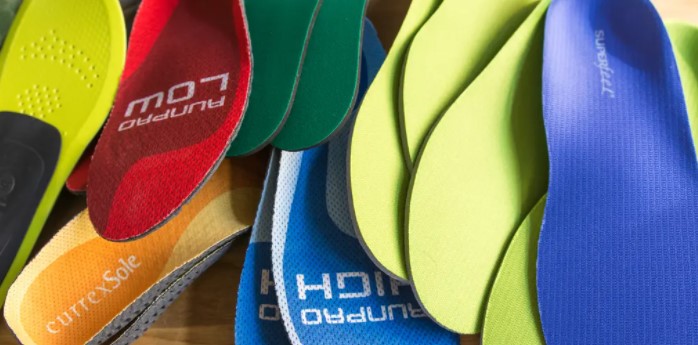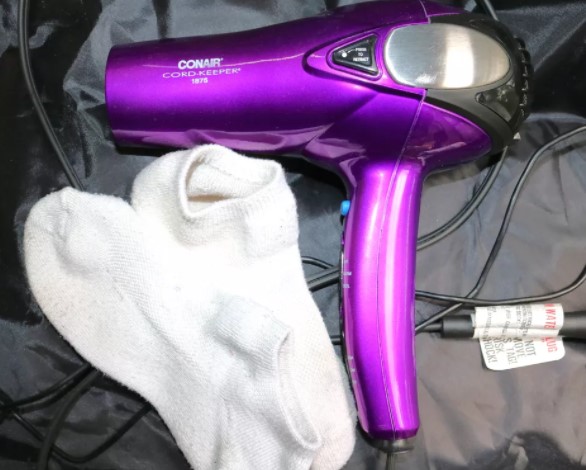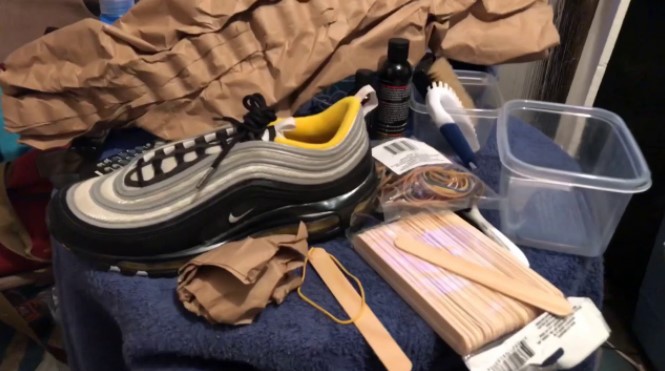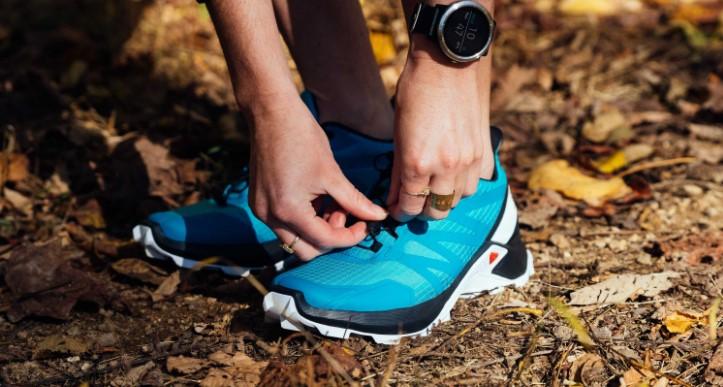Much every pair of footwear you purchase will require several days to break in and become comfortable on your feet. However, it is possible that you will end up purchasing a pair of shoes which are too narrow for your feet. As a result, if you can’t or don’t want to replace them, the only option you’d have is to stretch them to make them more comfortable for your feet.
People with wide feet are more likely than others to experience this problem. The shoes are comfortable in terms of length, but they pinch at the toes and the ball of the foot. In such a case, simply replacing the pair will not be of assistance. You will need to take steps to ensure that your running shoes are properly stretched to accommodate your wide feet.
How To Stretch Running Shoes For Wide Feet?
Fortunately, there are several safe methods for stretching your running shoes to compensate your broad feet, or whichever reason you need to do it, you can squeeze in a crumpled paper, use a shoe tree, or freeze water inside with a zip top. Here they are listed (and more) so you can see which technique is most viable to you:
1. Crumpled paper
The one the is probably cheapest and laziest trick you could do is the crumpled paper trick. Find some clean scratch papers and crumple them. Stuff a decent amount of those crumpled papers inside your shoes. Leave it there while you are not using it and it will leave your shoes a good stretch.
2. Replace the insoles with thinner ones
It may come as a surprise to you, but removing the insoles from the shoes allows for more space to be created inside the shoes. You can replace these surprisingly thick soles with some thinner ones to achieve the same result.
The same shoes, now that they have more space, should become more accommodating to your wide feet over time.
It is extremely safe to use this method because you are not making any changes to the upper of the shoes to soften or loosen it. As a result, your feet are more comfortable inside the shoes, and there is no damage done to the shoes.
3. Use a hairdryer in conjunction with thick socks
Heated shoes have a better fit because the fibers of the upper are looser and the shoes are stretched, which helps them to fit better on your wide feet when wearing them.
Warm air blowing away from the dryer is enough to stretch the pair, but not so much that it can damage the running shoes. The procedure to be followed is as follows:
Put on your shoes.
With the help of a hairdryer, make use of hot air to target the ball and toe areas.
Don’t focus the warm air on one spot for a long time. Just hover it around.
Running in your running shoes for a few minutes every day for 3-5 days should be sufficient to stretch them to the size you desire.
Extra tip: If you can wear a thick pair of socks throughout the process, it will significantly improve the final result.
4. Put your shoes in the freezer, literally
No, you do not have to put your shoes through a torturous process of submerging them in water and then freezing them for days on end.
Your running shoes will be stretched using this method, which will take advantage of a unique property of water.
Water possesses an intriguing characteristic. A small amount of expansion occurs when it transitions from the liquid to the solid state. You will be taking advantage of this characteristic of water to widen the soles of your running footwear. Here’s how it’s done:
Take a couple of zip-top bags.
Fill them up with water until they are completely full.
Zip-lock the plastic bags.
Place the zip bags inside the pair and wrap them with another bag to avoid getting dirty and leave them in the fridge overnight.
The next morning, you will discover that your running shoes are significantly wider than they were the night before.
If necessary, repeat this procedure a few times to achieve the desired fit for your running shoes.
5. Make use of a shoe tree
Stretching your running shoes for wide feet with a shoe tree is a professional solution that is available. You can expect a good result from this method. Furthermore, it does not cause any damage to the shoes themselves.
Shoe trees are designed to look like a bog-standard pair of shoes, so they are easy to find. As a result, they are effective in stretching the shoes while causing no structural change or harm to the pair of shoes. The following is how to make use of them:
Insert the left shoe tree into the left shoe and the opposite for the right shoe tree.
Then, with your hand on the widening handle at the end of the heel, rotate it clockwise until the toe block has been widened, which will cause the shoes to stretch.
Don’t fret about slightly overstretching the shoes. Once the shoe trees are removed, the shoes will shrink back a little in size.
Allow the pair to rest overnight to allow the shoe trees to do their job.
How To Tell If Running Shoes Aren’t The Right Fit
The fact that you are strutting around the weight rack is not a serious mistake. Running and rushing around in a pair that don’t fit properly, on the other hand, can be hazardous to your health.
To determine whether or not you are wearing the incorrect running shoes, keep an eye out for these red flags.
- You are unable to remove your shoes unless you completely loosen the laces.
- When you’re walking or running uphill, your heel slips a little bit.
- Your toenails are bruised after a long run, and/or you’ve developed Hammer Toe as a result of the run.
- Your Achilles tendon is feeling swollen or soft; your calves might be feeling some strain.
- The top of your foot may feel numb or strained.
- Your toes have bunions or corns on the sides of them.
- Your toes tingle after running a significant distance.
- You experience a sensation of stabbing in an area somewhere in your knee when jogging fast in a new pair of shoes.
Sometimes these problems don’t occur due to the fit. You might want to check first if you are using the right design of shoes and when you are to use them. Like choosing good running shoes for asphalt or choosing the right shoes for running off-road.
What Are The Foot Problems From Tight Shoes
It is possible that wearing tight shoes will make you look more fashionable, but it will compromise your comfort on your feet. More complex anatomy exists in the human foot, and wearing shoes that are too tight can cause a lot more harm than just making you feel uncomfortable at a social gathering. When selecting a new pair of shoes, it is important to consider comfort and fit to avoid unintended side effects.
Here are several issues that can arise as a result of wearing tight or ill-fitted shoes:
Pain in the foot – Tight-fit shoes, particularly in the forefoot, have been strongly reasoned to foot pain in recent years. Shoes that tight constrict the toes and limit the movement within the shoes.
Ingrown Toenails – Whenever the curves of the nails in your toes develop into the skin around them, this is known as an ingrown nail. It is most likely that an ingrown toenail will develop on your big toe due to excessive pressure on the due to shoes that are too small, tight, or flat for the shape of your feet
Toe Deformities – forcing your feet into ill-fitted shoes over time can result in toe deformities. This happens because your toes begin to adjust to the restricted space they are in. The following are examples of common toe problems:
- Bunion is a condition that causes the big toe to turn inward over time, resulting in swelling and pain.
- “Corns” refers to a callus that forms on or between your toes.
- It is a medical issue wherein the ball of someone’s foot becomes hurtful and agitated for an extended period of time. An aching, sharp, or even burning sensation could accompany the pain.
Diabetic Foot Ulcers – What You Should Know Patients with diseases such as diabetes are more likely than the general population to develop foot ulcers as a result of wearing restrictive footwear. This can develop when the shoe interior is frequently rubbing up against the foot skin.
Pain in other areas – If you are experiencing pain in your lower back to your legs, it is possible that you are wearing too-tight footwear.
Frequently Asked Questions (FAQs)
When you have bought your running shoes, the most probable reason could be your health. You wanted to do healthy activities such as running. With these, you might want to minimize the adverse effects of your running shoes on your health. Here are some common queries about running shoes:
What is the average lifespan of a pair of running shoes?
The straight answer is about 300 to 500 miles. Different pairs have different functionalities. A lightweight pair designed for agility and speed will not last as a heavy-duty trainer designed for everyday use. Another significant point to consider is how well a shoe is cared for and how well it is maintained. Another factor to consider is foot strike; someone who slams their feet down with each and every stride will wear out their shoes more quickly than someone who has an efficient stride.
Are new running or walking shoes required to be broken in?
The materials used in today’s running/walking shoes are chosen because they are more flexible and allow for a greater range of movement when compared to shoes from the past. This indeed reduces the break-in period; however, this does not imply that you should go running the day after purchasing a new pair of shoes.
It’s a good idea to break in a new pair of running or walking shoes gradually, even though today’s materials are better suited for faster break-in times than they were in the past. Start with the easier days to incorporate them into your running/walking routine once you’re comfortable with them.
Is it true that the surface on which I run or walk has an impact on how long a running or walking shoe lasts?
Absolutely! Rough surfaces such as asphalt, will cause significant wear and tear on both your running shoes as a result of the amount of time you spend on them. Find a while to incorporate running on softer surfaces, such as trails or grass into your routine, even if it is only sometimes.
Final Words
It is critical to select shoes that are properly fitted. The right shoes will maximize the support that your feet need, allow for plenty of room for your foot and toes, and be comfortable to wear. These are particularly important for athletic shoes that are designed to withstand rapid changes in foot position and movement. The better your shoes fit, the less likely it is that you will develop problems with your feet in the future.







